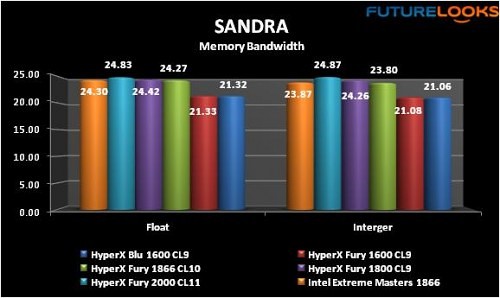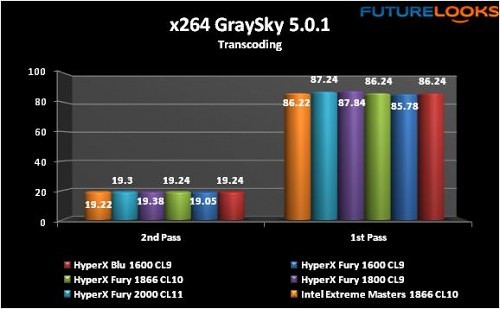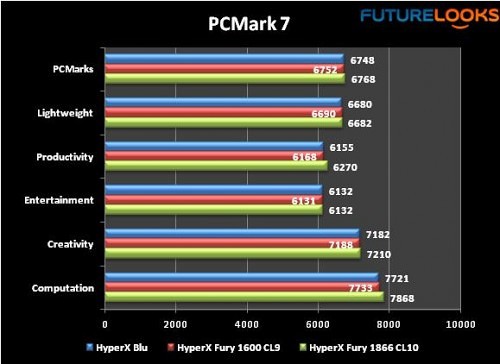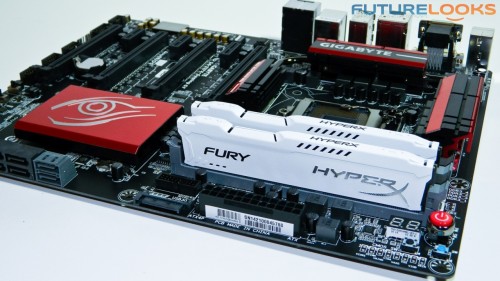Benchmarks
When it comes to memory performance, frequency is usually king, especially in regards to loading up video games, but rarely, if ever, affect frame rate. However, the CL or CAS Latency timing effects overall system performance especially when used with media programs like transcoding video. Lower timings mean less wait time (ms) is required between the CPU and memory. Keep that in mind when selecting your memory.
Benchmarks start with SANDRA Memory Bandwidth since we need a good reliable measure of just how much data can be moved between the CPU and memory. The x264 GraySky 5.0.1 multimedia benchmark will show us differences in frequency and timings when applied.
SANDRA – Memory Bandwidth
That 24.87 MB/s bandwidth is quite a bit compared to five years ago when 11 MB/s was considered fast. Bandwidth helps move data back and forth between the CPU thanks to the integrated memory controller. Bandwidth can be used more efficiently with lower timings which you’ll see next.
x264 GraySky 5.0.1
As you can see, the frequencies help a little. At 1866 MHz CL10, the Kingston HyperX Fury manages 87.24 frames in the first pass. However, dropping the frequency and timing to 1800 MHz CL9 gives the processor a slight boost to almost 88 frames. It doesn’t seem like much now, but you’ll be happy not having to wait as long for projects to complete.
Influencing Overall System Performance
There are system benefits to utilizing high performance DDR3 memory. While it may not be easy to notice doing more simplistic tasks like surfing the web, loading or playing video games. But, it is doing something. The gains made going from 1600 to 1866 MHz are much more discernible with bigger projects such as those that PCMark 7 puts the system through. The results are in the pudding, or benchmark as it were.
Final Thoughts
The Kingston HyperX Fury 16GB 1866 MHz DDR3 memory is an extremely attractive and affordable RAM kit for Z97 systems. It has both higher frequencies, respectable performance, stability, auto overclock PnP settings, and a Lifetime warranty. What you don’t see is that the HyperX Fury 1866 MHz CL 10 memory can actually operate with CL 9 timings as tested, indicating extra hidden performance for any system. There’s also a little bit of overclocking performance left, letting us reaching 2000-2133 MHz CL 11, which is pretty respectable for entry level HyperX memory.
Finally, the Kingston HyperX Fury heat sink design looks great. While the black, blue and red look really nice, the HyperX Fury in white looks amazing leaving us wondering why it doesn’t come in DDR4 memory (yet). It’s one of those colors that just didn’t seem possible to make look good given all the contrasting motherboard themes out there. However, it rocks its exceptional curves!
How much does the Kingston HyperX Fury 1866 MHz memory cost? The 8GB start at $83 and 16GB $160 US . The 1600 MHz memory is about $10 less which makes the higher frequency 1866 MHz a better buy, in our opinion. With such great looking entry level memory at a good price, it’s hard to picture anything else in our system. And for those of you that want nothing but performance, without any intervention in the BIOS, it’s hard to beat a memory kit that configures itself. We’re slapping an Editors’ Choice Award on these.
Pros:
- Respectable stock XMP performance
- Exceeds specifications when tuned manually
- Fantastic looking heat spreaders (especially in white)
- Highly affordable 16GB memory kits
- Perfectly stable and compatible with all our Z97 boards
Cons:
- No HyperX Fury DDR4 available (Yet!)
Overall Rating: 9.75 / 10.0

Help Us Improve Our Reviews By Leaving a Comment Below!





